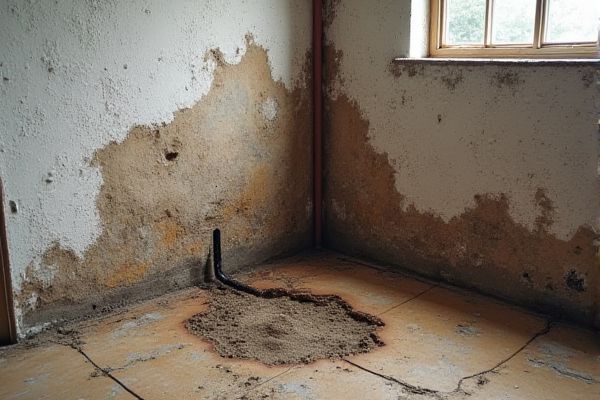
A slab leak involves water escaping from the plumbing pipes beneath your concrete floor, often causing moisture damage and increased water bills, while a foundation crack in the basement refers to structural damage that can lead to water seepage and compromised stability. Understanding the differences between these issues is crucial for addressing potential risks to your home's integrity--read on to learn how to identify and treat slab leaks versus foundation cracks in your basement.
Table of Comparison
| Feature | Slab Leak | Foundation Crack |
|---|---|---|
| Definition | Water leak from pipes beneath concrete slab | Structural crack in basement foundation wall or floor |
| Primary Cause | Corrosion, shifting soil, poor installation | Soil movement, settling, pressure, poor construction |
| Signs & Symptoms | High water bills, damp floors, mold, low water pressure | Visible cracks, water seepage, uneven floors, gaps |
| Location | Under concrete slab foundation | Basement walls or floor foundation |
| Water Damage Risk | High - can cause flooding and mold under slab | Moderate - can lead to water seepage and structural issues |
| Repair Method | Pipe replacement or epoxy pipe lining | Crack sealing, waterproofing, structural reinforcement |
| Cost Range | $1,000 to $4,000+ | $500 to $3,500+ |
| Urgency | High - prevent water damage and mold | Medium - monitor for progression and leaks |
| Inspection Tools | Thermal imaging, pressure test, electronic leak detection | Visual inspection, moisture meter, structural assessment |
Understanding Slab Leaks: Causes and Signs
Slab leaks occur when water pipes beneath your concrete foundation develop cracks or corrosion, often due to shifting soil or poor installation. Common signs include damp spots on basement floors, a sudden increase in water bills, and the sound of running water when fixtures are off. Detecting slab leaks early is crucial to prevent worsening foundation damage and costly repairs.
What Are Foundation Cracks in Basements?
Foundation cracks in basements are fractures or separations in the concrete or masonry walls that support your home's structure. These cracks often result from soil movement, moisture changes, or settling and can lead to water seepage, mold growth, or structural damage if left untreated. Identifying and repairing foundation cracks promptly is essential to maintaining your basement's integrity and preventing costly repairs.
How Slab Leaks Differ from Foundation Cracks
Slab leaks occur when water pipes embedded in the concrete foundation leak, causing moisture-related damage and increased water bills, while foundation cracks are structural issues resulting from soil movement or settling, potentially compromising the basement's stability. Unlike foundation cracks, slab leaks often produce warm, damp spots on floors and must be detected through specialized leak detection equipment. Addressing slab leaks typically involves repairing or replacing damaged plumbing beneath the slab, whereas foundation cracks may require sealing, underpinning, or other structural reinforcements to prevent further damage.
Common Causes of Basement Foundation Cracks
Basement foundation cracks commonly result from soil movement caused by expansive clay, poor drainage, or improper compaction around the foundation. Hydrostatic pressure buildup from excessive water infiltration exerts stress on basement walls, leading to cracks. Temperature fluctuations causing freeze-thaw cycles and structural settling also contribute significantly to basement foundation damage.
Warning Signs: Slab Leak vs Foundation Crack
Warning signs of a slab leak often include unexplained increases in water bills, damp or warm spots on the floor, and the sound of running water when no fixtures are in use. Foundation cracks in the basement typically present as visible fissures in walls or floors, water seepage during heavy rain, and doors or windows that stick or fail to close properly. Understanding these symptoms helps you identify whether plumbing issues or structural damage are affecting your home's foundation.
Potential Risks of Ignoring Slab Leaks
Ignoring slab leaks can lead to severe structural damage, including foundation weakening and increased risk of costly repairs in the basement area. Prolonged moisture exposure promotes mold growth and wood rot, compromising indoor air quality and overall health. Early detection and repair are critical to preventing water damage that a foundation crack might exacerbate when paired with an untreated slab leak.
Dangers of Untreated Foundation Cracks
Untreated foundation cracks in a basement allow water infiltration, which can lead to mold growth, wood rot, and structural weakening. These cracks compromise the integrity of the home's foundation, increasing the risk of costly repairs and potential safety hazards. Ignoring foundation damage exacerbates soil erosion and destabilizes the basement floor, endangering the entire building's stability.
Slab Leak Repair Methods for Basements
Slab leak repair methods for basements typically involve advanced techniques such as electronic leak detection, epoxy pipe lining, and trenchless pipe replacement to minimize damage to your foundation. Accurate detection is crucial to prevent water damage and mold growth, preserving the structural integrity of your basement slab. Prompt and professional slab leak repairs ensure your basement remains dry and your home's foundation stable.
Solutions for Basement Foundation Crack Repair
Effective solutions for basement foundation crack repair include epoxy injection and polyurethane foam injection, both designed to seal and strengthen cracks to prevent water infiltration and structural damage. Carbon fiber strips and steel reinforcements provide additional support for larger or active cracks, ensuring long-term stability. You can also consider waterproof coatings and proper drainage systems to protect your basement from further issues caused by foundation cracks.
Slab Leak vs Foundation Crack: Prevention Tips
To prevent slab leaks, consistently monitor water pressure and inspect plumbing for early signs of corrosion or damage, ensuring timely repairs to avoid water damage in your basement. Foundation cracks can be minimized by controlling soil moisture levels around your home through proper drainage systems and gutter maintenance, preventing soil expansion and contraction that cause structural stress. Regular basement inspections and maintenance will help you address small issues before they develop into costly repairs.
 homyna.com
homyna.com